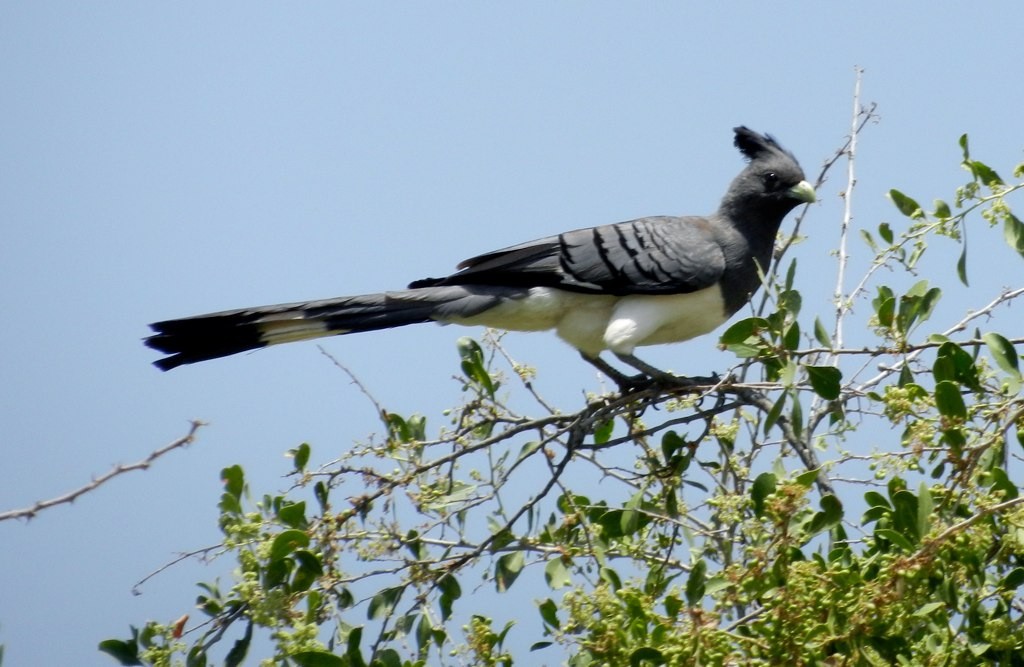White-bellied Go-away-bird
A species of Go-away bird Scientific name : Crinifer leucogaster Genus : Go-away bird
White-bellied Go-away-bird, A species of Go-away bird
Botanical name: Crinifer leucogaster
Genus: Go-away bird
Content
Description General Info
 Photo By j_iglar , used under CC-BY-SA-2.0 /Cropped and compressed from original
Photo By j_iglar , used under CC-BY-SA-2.0 /Cropped and compressed from original Description
This species averages 51 cm (20") in length. Its long, pointed grey and black tail with a white median band is characteristic of the species. It has a white under-wing patch, visible in flight. The adult has a grey head and leading to a dark grey to blackish pointed crest with an approximate length of 6 cm. The belly and under-tail coverts are white, giving the bird the first part of its name "white-bellied". The bill is black in male, pea-green in the female (becoming yellowish during the breeding season). Females also tend to be larger, weighing 225g - 250g, where as males only weighed 170g - 225g. The juvenile is similar to adults, with the plumage being more brown, especially on wing-coverts. Typical calls are a nasal haa-haa-haa, like bleating of a sheep, and a single or repeated gwa (or g'away), this distinctive call is where the bird gets the latter part of its name "go-away". It flies from tree to tree in loose straggling groups, calling loudly. 
Size
50 cm
Habitat
Their habitat consists of hot acacia steppe, savanna, and woodland areas. It avoids deep forest, but the species has been seen at a range of elevations, from sea-level up to 2000m. Individuals of the species are limited to its locality due to water availability, but the species occurs across a vast area in E and NE Africa. It is found in Somalia, W Ethiopia, S Sudan, NE Uganda, N and E Kenya and southwards into the eastern plateau of Tanzania. 
General Info
Behavior
The white-bellied go-away-bird is sedentary in its range, wandering locally when searching for water and food sources. They are gregarious birds that do not migrate but move in family groups of up to 10. They are territorial and a breeding pair likely maintains its territory year round. Feeding The white-bellied go-away-birds feed primarily on plant matter such as fruits, flowers, nectar, seeds and buds of acacias. The species is also known to eat some invertebrates, such as winged termites found when foraging. The species are very agile climbers, allowing for easy foraging in the tree tops. As a result of these feeding habits the White-bellied Go-away-bird is considered a pest in some regions, raiding orchards and plantations of fruiting trees and vegetable crops. Breeding During the breeding season (which usually starts with the rainy season), White-bellied Go-away-birds become much more vocal. This varies according to range. The birds exhibit courtship behaviour, including chases from tree to tree and displays, where the birds bow and flick the long tail whilst raising and lowering the crest. The black and white pattern is enhanced by these postures and this is believed to be the purpose of the patterning. The White-bellied Go-away-bird is monogamous and mutual feeding has been recorded between partners. The nest is placed in acacia-type tree, 3-12m above the ground. The female lays 2-3 pale bluish eggs. Both sexes incubate for approximately 4 weeks. The first flight of chicks occurs approximately 4–5 weeks after hatching. However, they still depend on parents for food for several weeks after fledging. 
Distribution Area
Their habitat consists of hot acacia steppe, savanna, and woodland areas. It avoids deep forest, but the species has been seen at a range of elevations, from sea-level up to 2000m. Individuals of the species are limited to its locality due to water availability, but the species occurs across a vast area in E and NE Africa. It is found in Somalia, W Ethiopia, S Sudan, NE Uganda, N and E Kenya and southwards into the eastern plateau of Tanzania. 
Species Status
The population of white-bellied go-away-birds has not been quantified. Its conservation status is stated to be "of least concern". This is because the population is not believed to be below 10,000 mature individuals and the bird has a wide distribution of over 3 million km, meaning it does not meet vulnerability criteria. Furthermore, the population appears stable and not to be in decline. 
Scientific Classification
Phylum
Chordates Class
Birds Order
Turacos Family
Turacos Genus
Go-away bird Species
White-bellied Go-away-bird